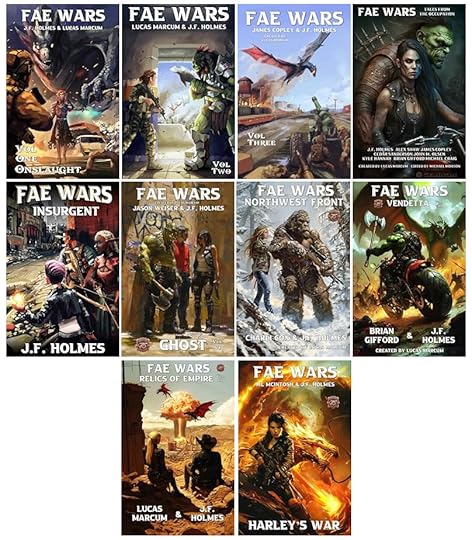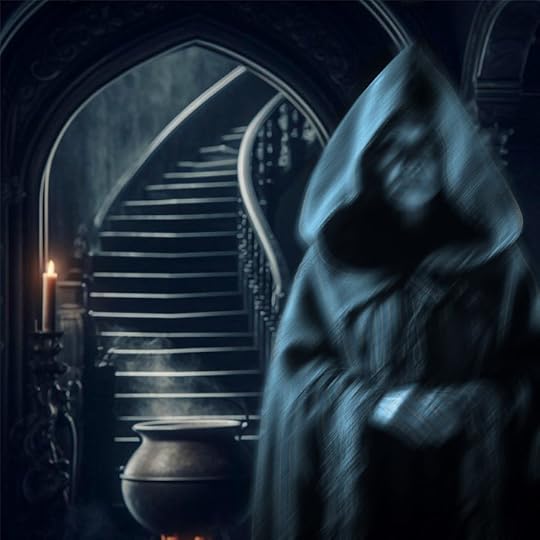Chris Thorndycroft's Blog
November 11, 2025
My Next Novel …
It’s about time I let you know what my next novel is going to be and this one is a bit different! I’m pleased to say that I have signed a contract with Cannon Publishing, a New-York-based publisher that specialises in military sci-fi and fantasy to write three novels in their ongoing The Fae Wars series.
What’s The Fae Wars? Well, it falls into the subgenre of ‘urban fantasy’ which is basically fantasy tropes and supernatural elements set in a modern, urban context. The backstory of Fae Wars is that our modern world has been invaded by creatures from another realm including elves, orcs and dragons. Naturally, the military forces of the world fight back and the result is something like Tom Clancy meets Tolkien on a massive, global scale.
There are currently ten books in the Fae Wars series, with over eight different authors involved, providing different points of view and scenarios as the war unfolds. It’s very much a collaborative process and we have some pretty interesting discussions in the Facebook group developing the lore and mythology of the series!

To date, all of the Fae Wars novels have been set in the US but Cannon Publishing wants to expand the theatre of operations to include the UK and was looking for an author with a background in a certain mythical figure of British legend who, through a series of events, returns to lead the British resistance agasint the Fae.
Now, if you know me or have read any of my books, then you’ll have a fair idea of who this mythical British hero might be 

I’m 20k words into the first book in a spin-off trilogy tentatively titled Fae Wars: Albion and am having a blast! When I wrote my Arthur of the Cymry series, I wanted to portray a realistic version of the legend of King Arthur that could have actually happened. While I found that idea fascinating, I always felt a little constrained in that I had to get rid of the more fantastical parts of King Arthur’s story. This time around, I get to go full-Mallory and have Arthur wielding a magic sword against hordes of orcs and elves!
The Arthur of The Fae Wars is a different character to the Arthur I created in my own books, and I get to skew closer to the more familiar version of the story featuring Merlin, the Lady of the Lake and Morgan le Fey. It’s great fun to finally do the fantasy version of King Arthur AND tie it in to an already up and running story set in the modern world.
The first installment of Fae Wars: Albion should be published early next year, but in the meantime, do check out the rest of the series. All are in Kindle Unlimited and most have audio versions too!
November 4, 2025
Some Historical Fiction Books Recs for November!
I always find November a bit of a strange month. Sandwiched between Halloween and Christmas, it always feels a bit quiet. I suppose Americans have Thanksgiving to look forward to but here in Europe, its a bit of a lull before the December storm. It’s the perfect time to stock up on a few new books though, and if you’re looking for some great historical fiction reads to get you through the month, then take a look at this group promo!

October 12, 2025
Ghosts in Arthurian Legend
It’s October, my favourite month of the year! I love the turning of the season to gold and orange and the creepy notion of spirits returning to haunt us. Now, having written several books dealing with the legend of King Arthur, I started to wonder if ghostly spirits ever appear in Arthurian legend.
Belief in ghosts in the Middle Ages wasn’t as common as you might think. While the pagan religions of Europe certainly had room for tales of the spirits of the dead returning, early Christianity strongly disapproved of such things with Saint Augustine claiming that ghostly apparitions were merely demonic illusions. That doesn’t mean that the later Arthurian romances, filled with supernatural goings on as they are, don’t have at least a couple of references to what we might consider to be ghosts.

An early Welsh tale called Branwen ferch Llŷr found in The Mabinogion, refers to a magical cauldron which restores life to dead warriors, although robbing them of their speech. Horrifying though this might be, these beings are rather more like zombies than ghosts. It is in later legends that we see a few encounters with beings of a more ethereal nature.
A really chilling tale perfect for Halloween is The Awntyrs off Arthure, a Middle-English poem known in modern English as The Adventures of Arthur at Tarn Wadling a translation of which can be read here. In this, Gawain and Guinevere (here named ‘Gaynore’) become separated from Arthur and his knights while on a hunt. At the edge of a lonely mere, they encounter a hideous specter, shrouded in cloth and covered in serpents and toads. This ghostly woman reveals herself to be Guinevere’s dead mother who warns the pair to live morally and give charitably to the poor. She also predicts the fall of Arthur and the Round Table due to the treachery of one who currently ‘plays ball’ at Arthur’s court (Mordred, most likley).
The battle with Mordred looms large in Arthurian myth and is the reason the spirit of Gawain himself returns to warn Arthur in Thomas Mallory’s Le Morte D’Arthur. On the eve of battle, Arthur dreams that he is visited by Gawain who was savagely slain by Mordred earlier in the tale. Gawain appears in the company of all the women he fought for in life and claims to have been sent by God to persuade Arthur to make peace with Mordred else many men on both sides will be slain.
Despite the disapproval of Augustinian teachings, ghosts found more of a place in Christianity with the development of the concept of purgatory from the 11th century onwards. It is after this that we see such specters in the Arthurian tales. The souls in the above tales have a specific purpose to warn the living against following the destructive paths they are on.
September 4, 2025
Stock up your Kindle this September!
Looking to fill your Kindle with some great action-adventure reads this month? Take a look at this promo featuring a ton of books all available for free in Kindle Unlimited!

August 5, 2025
Grab some Historical Fiction Book Deals!
This August, the eBook of my Robin Hood retelling, Lords of the Greenwood, is only $0.99/£0.99 from Amazon! You can grab it (and tons of other great historical fiction books) through either of the below promos. Happy reading!


July 15, 2025
‘The First Pendraig’ is Out Now!
Today is the day! The First Pendraig, the final book in the Dragon of the North trilogy is now available in print and for Kindle from Amazon! Grab your copy here! As with most of my other books, you can read The First Pendraig for free as part of Kindle Unlimited. While the eBook is exclusive to Amazon, you will be able to pick up print versions from other outlets soon.

To set the scene a little, here is a short post about a key battle in the development of sub-Roman Britain and an important part of the plot for The First Pendraig.
The Battle of Guoloph
And from the reign of Vortigern to the quarrel between Guitolinus and Ambrosius, are twelve years, which is Guolopum, that is Catgwaloph – The Historia Brittonum
Although much of The First Pendraig is set in North Wales and concerns Cunedag’s conquest of the territory and the founding of the Kingdom of Gwynedd, some of the early chapters deal with an obscure conflict in southern Britain that seems to have marked a turning point in its post-Roman history.
The Battle of Guoloph is mentioned in the 9th century Historia Brittonum as being between Ambrosius and Vitalinus, though the chronicle does not state what the battle was about. Ambrosius no doubt refers to Ambrosius Aurelianus, whom other sources (starting with Gildas) claim was a great leader of Roman stock who rallied the Britons against the Saxons.
Ambrosius is mentioned several times in the Historia Brittonum, which states that Vortigern, the apparent king of the Britons, lived in fear of him as well as fear of Roman invasion. Could these two fears be one and the same? Did Ambrosius, a Roman and a rival leader, represent a return to Roman rule while Vortigern strove for an independent Britain under his own leadership?

Who then, was Vitalinus? Interestingly, the Historia Brittonum lists Vortigern’s father and grandfather as Vital(in)us, suggesting that it was a family name. Then there is the theory that Vortigern is a title, or at least, a chosen name meaning something like ‘overlord’ picked for political reasons much like Stalin or Lenin. Could Vortigern’s real name have been Vitalinus? Why then, does the author of the Historia Brittonum state that the Battle of Guoloph took place 12 years after the reign of Vortigern but then also has Vortigern playing a part in the later Saxon settlement of Kent and quarrelling with Bishop Germanus who visited Britain in the late 440s?
There is a theory that there were two Vortigerns, a father and a son, who both ruled large portions of Britain. Perhaps they were both called Vitalinus and assumed the title ‘Vortigern’ upon their rise to power. These homegrown ‘overlords’ would naturally have come into conflict with men like Ambrosius Aurelianus who wanted to return Britain into the fold of the Roman Empire. Here, we may get a glimpse at the cause of the mysterious Battle of Guoloph which was perhaps between a pro-Roman faction and an anti-Roman one.
Guoloph has been identified as Nether Wallop in Hampshire, with many modern historians referring to the incident as the ‘Battle of Wallop’. Nearby Amesbury is possibly named after Ambrosius and there are a few hillforts in the area including Old Sarum and Danebury which would have provided suitable encampments for warbands. I have named these locations as Cair Caradog and Din Belgae in my book respectively, the first being a name for Old Sarum in the Welsh Chronicle of the Britons and the second being named after the Belgae tribe who once inhabited the area and also gave their name to the Roman town of Venta Belgarum (Winchester).
 Here’s a map of south central Britain from The First Pendraig which shows the general area concerned with the Battle of Guoloph.
Here’s a map of south central Britain from The First Pendraig which shows the general area concerned with the Battle of Guoloph.
July 6, 2025
Some Great Historical Fiction Books for July!
While you’re awaiting the release of The First Pendraig on July 15th (order your copy here), why not grab some historical fiction deals to tide you over? This group promo has a ton of interesting books in the genre, so take a look!

July 2, 2025
‘The First Pendraig’ is Now Available to Preorder!
The final book in the Dragon of the North trilogy is now available to preorder from Amazon! Secure your copy here!

I can’t believe this trilogy is now complete! It’s been a fun ride and I’d like to thank you for your support along the way. I hope you enjoy this concluding chapter in Cunedag’s life and the founding of the Kingdom of Gwynedd and please consider leaving a review! Here’s the blurb;
Britain, 437 A.D.
The Roman legions have gone. The Britons stand alone. The clouds of civil war have parted and there is hope of a bright future for the island.
Cunedag of the Votadini, hero of the Britons, has attracted the attention of one who would make himself overlord of the whole island. Vertigernus, King of the Britons in all but name, has a proposition for him; rid the region of Venedotia of the Gaels who have plagued it for generations. His reward? A new kingdom to rule and a legacy to leave his nine sons.
But Cunedag’s final war will be hard and full of sorrow. Familial strife, royal intrigue and a mysterious cult of priestesses must be dealt with before the dragon banner can be planted in the green hills of Venedotia.
The First Pendraig is the thrilling conclusion to the Dragon of the North trilogy, in which King Cunedag, a dark age warlord, builds the Kingdom of Gwynedd from the ashes of post-Roman Britain.
June 5, 2025
The Pendraig Explained
I can’t believe that the end is in sight for my Dragon of the North trilogy which I began way back in January 2024! Book 3 is now written and entering the editing phase with a planned July release so look out for a cover reveal soon! If you haven’t already, then get started here and don’t forget to leave a review!
I can also reveal the title for the concluding entry in Cunedag’s saga. Book 3 will be called The First Pendraig. What’s a pendraig, you ask? Well, ‘Pendraig’ (or ‘Pen Ddraig’) is an old Brythonic word which literally means ‘head dragon’ and has been anglicized as ‘Pendragon’. Recognisable to any reader of more modern Arthurian literature, Pendragon is often given as King Arthur’s family name, but that’s not quite how it was intended.
The first person to be given the epithet Pen Draig was a warrior in early Welsh poetry called Uthyr whom Geoffrey of Monmouth later claimed was Arthur’s father in his influential History of the Kings of Britain. Originally an entirely separate character, Uthyr is a mysterious figure whose epithet may have been a military title.
This works on the theory that ‘draig’, as well as meaning dragon, was also used to mean warrior. Therefore, Uthyr would have been the ‘chief of warriors’ which certainly sounds like a title rather than a surname, perhaps he was even the ‘leader of battles’ which Arthur would be called later in the Historia Brittonum.
Dragons feature heavily in early Welsh history and indeed, the modern Welsh flag is emblazoned with Y Ddraig Goch (the Red Dragon). The earliest use of the red dragon as a symbol of British (i.e. Welsh) nationality is in the Historia Brittonum in which King Vortigern struggles to build a castle on a hill due to the presence of two dragons beneath it; a red one symbolising the Britons and a white one symbolising the Saxons.
 Detail from Lambeth Palace Library MS 6 folio 43v illustrating an episode in Historia Regum Britanniae (c. 1136) showing Vortigern, Merlin and the two dragons.
Detail from Lambeth Palace Library MS 6 folio 43v illustrating an episode in Historia Regum Britanniae (c. 1136) showing Vortigern, Merlin and the two dragons.The adoption of the red dragon as a national emblem by the Britons may go all the way back to the Roman period in which cavalry units stationed in Britain used the ‘draco’ standard; a hollow bronze head to which was attached a long fabric sleeve much like a modern windsock. When galloping, air would rush through the mouth of the bronze head and inflate the sock, while creating a whistling sound to terrify the enemy. The draco was adopted from eastern peoples like the Dacians and Sarmatians and became the standard for cavalry units of the late empire like those in which Cunedag serves in my novels.
 The draco standard was carried by late-Roman cavalry units and is a possible ancestor of the Welsh dragon. This replica draco was made by Stefan Jaroschinski. For more info, visit Robert Vermaat’s site here.
The draco standard was carried by late-Roman cavalry units and is a possible ancestor of the Welsh dragon. This replica draco was made by Stefan Jaroschinski. For more info, visit Robert Vermaat’s site here.There is nothing to explicitly link Cunedag with the red dragon or the epithet of Pendraig, but his grandson, Maelgwn, was called ‘Dragon of the Isle’ by Gildas and early Welsh poets used the dragon as an image for military chieftains. The bard Taliesin even refers to Owain ap Urien as ‘Owain ben draic’, making it clear that Uthyr wasn’t the only person to be called ‘Pendragon’. Later Welsh leaders such as Owain Gwynedd, Llywelyn ap Gruffudd and Owain Glyndŵr are also referred to as dragons, the latter of which raised the banner of a golden dragon at Caernarfon during the Battle of Tuthill in 1401 (himself being referred to as ‘Y Ddraig Aur’ – the Golden Dragon).
The dragon, sometimes gold but more often than not, red, continued to be used in various Welsh heraldic devices and even by the House of Tudor; a Welsh dynasty which held the throne of England from 1485 to 1603. The current Welsh flag was not officially recognised until 1959.
 The flag of Wales, Y Ddraig Goch (meaning ‘the Red Dragon’), consists of a red dragon passant on a green and white field. The colours of green and white are the colours of the Tudor family.
The flag of Wales, Y Ddraig Goch (meaning ‘the Red Dragon’), consists of a red dragon passant on a green and white field. The colours of green and white are the colours of the Tudor family.
June 2, 2025
Historical Fiction Books for June!
Here’s a couple of group promos featuring some great historical fiction reads for June including my book Rotherwood: A Prequel to Ivanhoe.





